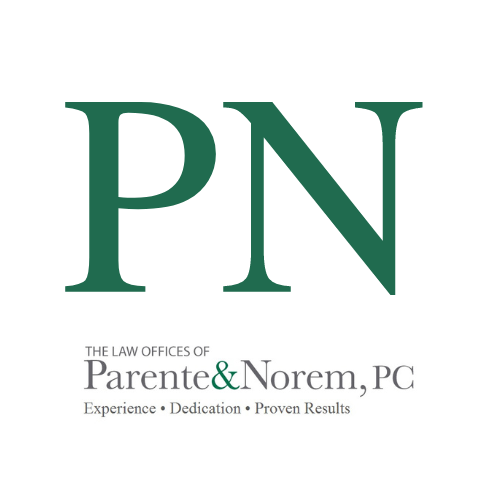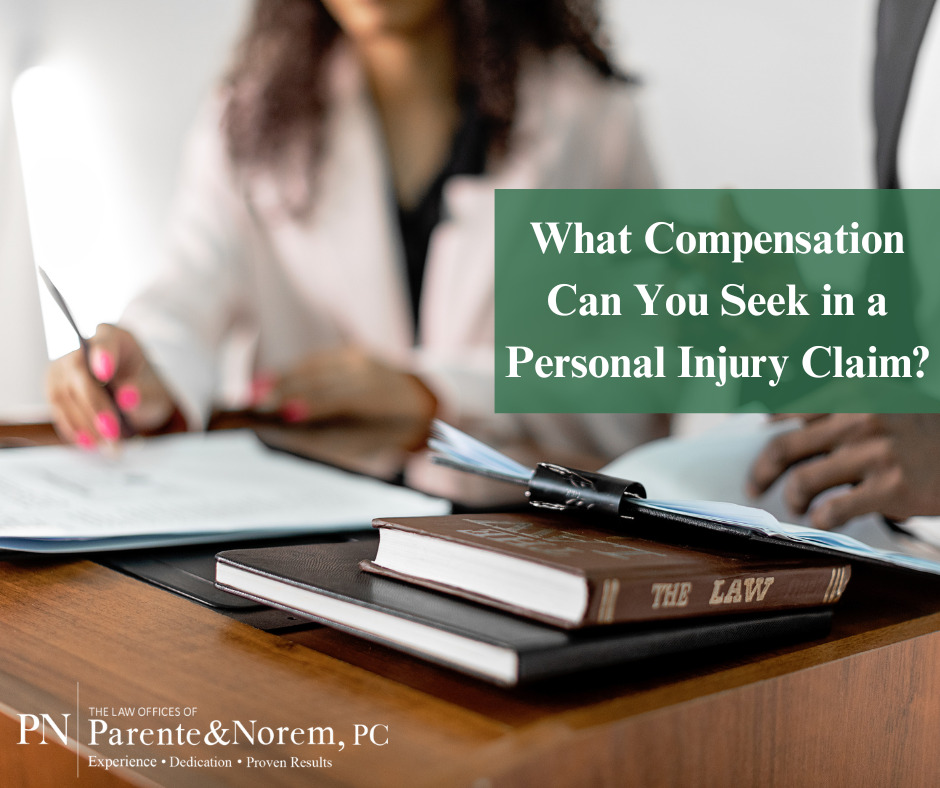
P&N BLOG | What Compensation Can You Seek in a Personal Injury Claim?
If you’ve been injured due to someone else’s negligence or wrongful actions, understanding your rights and the compensation available is essential. Personal injury laws exist to ensure that victims can recover damages for their losses, whether financial, emotional, or otherwise. In this post, we’ll break down the different types of compensation you may be entitled to, including economic and non-economic damages, punitive damages, and wrongful death damages. We’ll also discuss limitations on injury compensation and how you can maximize your claim.
Types of Personal Injury Compensation
Economic Damages
Economic damages cover tangible financial losses resulting from an injury. These are relatively straightforward to calculate and may include:
- Medical Bills: Reimbursement for hospital stays, surgeries, medication, rehabilitation, and other medical expenses related to your injury.
- Future Medical Costs: Compensation for ongoing or long-term medical care required due to permanent injuries.
- Lost Wages: Coverage for income lost while recovering from the injury.
- Future Lost Earnings: If your ability to work is permanently affected, you may be compensated for the income you would have earned.
- Property Damage: Reimbursement for any personal property damaged in the incident.
- Other Out-of-Pocket Expenses: Any additional costs incurred due to the accident, such as transportation for medical appointments.
Estimating these damages involves reviewing medical records, employment history, and expert opinions on future financial impact.
Non-Economic Damages
Non-economic damages account for losses that do not have a direct financial value but significantly impact your quality of life. These may include:
- Pain and Suffering: Compensation for the physical pain and discomfort endured due to the injury.
- Emotional Distress: Coverage for psychological trauma, such as anxiety, depression, or PTSD, resulting from the accident.
- Loss of Consortium: Compensation for the loss of companionship, intimacy, or support from a spouse or family member.
- Disfigurement: Damages awarded for permanent scarring or disfigurement caused by the injury.
- Loss of Enjoyment of Life: Compensation for the inability to participate in activities that once brought joy.
Punitive Damages
Punitive damages are awarded in cases where the defendant’s conduct was more than just negligent—it was reckless or intentionally harmful. Unlike economic and non-economic damages, punitive damages are not meant to compensate the victim but rather to punish the wrongdoer and deter similar behavior in the future. The amount awarded depends on the severity of the misconduct.
Wrongful Death Damages
If a loved one has died due to someone else’s negligence, their estate or family members may be entitled to wrongful death damages, which can include:
- Medical expenses incurred before death
- Pain and suffering experienced before death
- Funeral and burial expenses
- Loss of financial support the deceased would have provided
- Emotional distress and mental anguish experienced by surviving family members
- Loss of consortium (companionship and support provided by the deceased)
Limitations on Injury Compensation
While personal injury compensation is designed to provide full recovery, some legal and practical limitations may apply:
Tort Reform Limits
Some states have laws that cap the amount of compensation victims can receive, especially for non-economic and punitive damages. These limits are most common in medical malpractice cases and other specific claims.
Insurance Policy Limits
Most injury claims are paid through insurance policies, which have coverage limits. If your damages exceed the defendant’s policy limits, you may have difficulty collecting the remaining amount directly from the responsible party.
Seeking the Compensation You Deserve
Personal injury claims can be complex, involving multiple categories of damages and legal considerations. To ensure you receive fair compensation, it’s crucial to work with an experienced personal injury attorney who can guide you through settlement negotiations or court proceedings.
If you or a loved one has suffered an injury due to another’s negligence, The Law Offices of Parente & Norem, P.C. can help. Call or text us today for a free case evaluation at 312.641.5926, or fill out a contact form on our website.
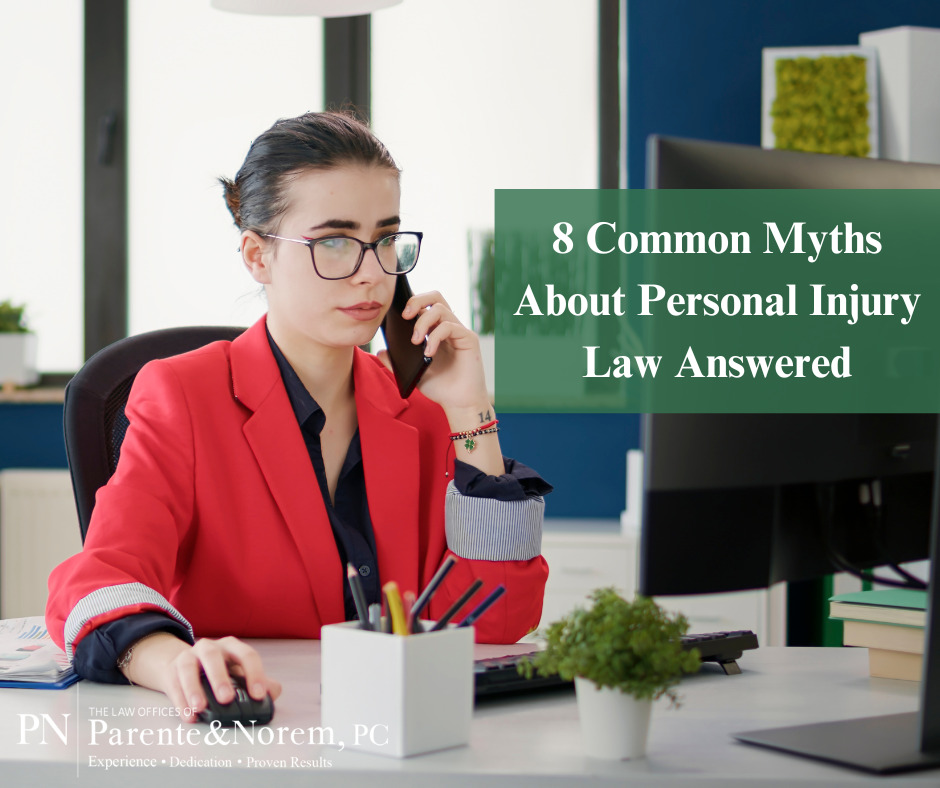
P&N BLOG | 8 Common Myths About Personal Injury Law Answered
When you’re injured due to someone else’s negligence, navigating the legal process can feel overwhelming. Unfortunately, many people shy away from filing a personal injury claim because of common misconceptions. These myths often prevent victims from seeking the compensation they rightfully deserve.
At The Law Offices of Parente & Norem, P.C., we believe in empowering injury victims with accurate information. That’s why we’re debunking some of the most common myths about personal injury law in Illinois. This way, you can make informed decisions if you ever find yourself in this situation.
Myth #1: Minor Injuries Aren’t Worth a Personal Injury Claim
Fact: Even seemingly minor injuries can have long-term consequences. Some injuries don’t show symptoms right away but worsen over time. Seeking medical attention is crucial, and filing a claim ensures you receive proper compensation for any future complications.
Myth #2: If You Have Insurance, You Don’t Need a Lawyer
Fact: Insurance companies are businesses, and they aim to pay out as little as possible. They may offer low settlements that don’t cover your full expenses. A personal injury lawyer will advocate for your rights and help you get the compensation you truly deserve.
Myth #3: You Can File a Personal Injury Case Anytime
Fact: Illinois has a statute of limitations for personal injury cases. If you wait too long, you could lose your right to seek compensation. Additionally, filing sooner helps preserve evidence and witness testimonies that may weaken over time.
Myth #4: Filing a Lawsuit Will Ruin Someone’s Life
Fact: Many people hesitate to file claims against friends, family members, or employers. However, in most cases, insurance companies, not individuals, pay settlements. Your focus should be on your recovery, not on protecting the responsible party from financial consequences.
Myth #5: Personal Injury Claims Are Only for “Greedy” People
Fact: Seeking compensation is about fairness, not greed. Medical bills, lost wages, rehabilitation costs, and emotional distress add up quickly. A personal injury claim ensures that you’re not left shouldering these burdens alone.
Myth #6: Compensation Is Guaranteed
Fact: While many personal injury cases settle, compensation is never guaranteed. Every case is unique, and the amount you receive depends on factors like evidence, liability, and the skill of your attorney.
Myth #7: Holding Out Longer Leads to a Bigger Settlement
Fact: A skilled attorney can negotiate a fair settlement without unnecessary delays. Waiting too long without legal strategy could weaken your case, especially if key evidence deteriorates.
Myth #8: Personal Injury Cases Are Overloading the Courts
Fact: Contrary to popular belief, personal injury cases make up only a small percentage of civil court cases. In fact, the number of cases has declined in recent years.
Know Your Rights & Don’t Let Myths Hold You Back
If you’ve been injured due to someone else’s negligence, pursuing a personal injury claim is not only your right but often a necessity for your financial and physical recovery. Having the right legal team on your side can make all the difference.
At The Law Offices of Parente & Norem, P.C., we fight for injury victims and win big cases. Call us today at 312-641-5926 for a free consultation because you deserve justice and fair compensation.
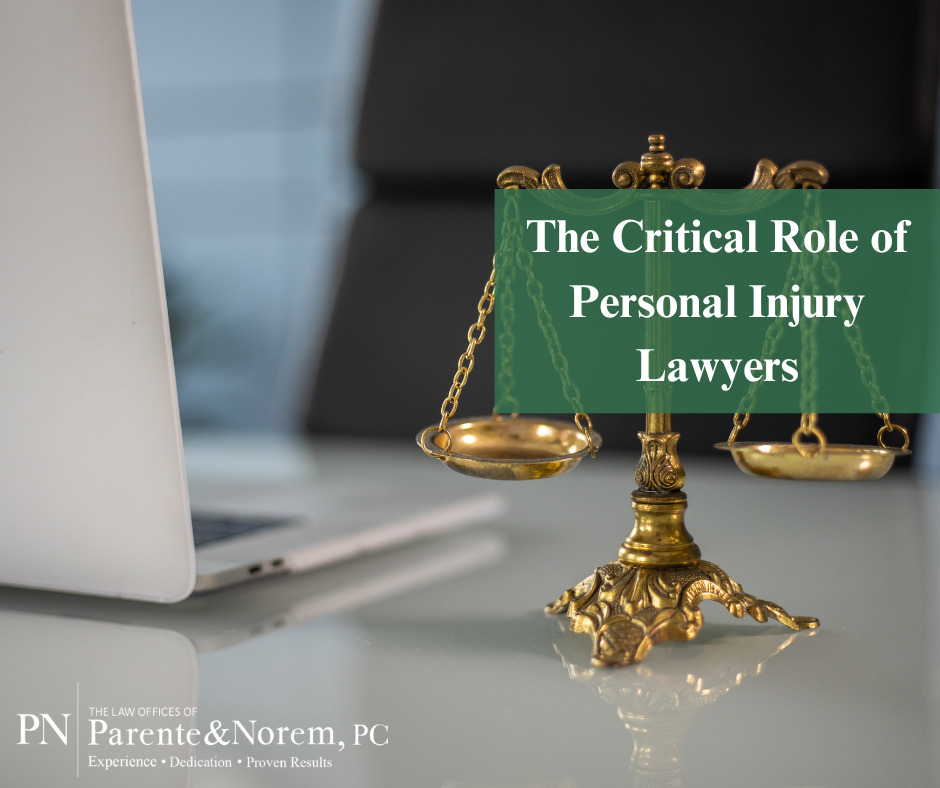
P&N BLOG | The Critical Role of Personal Injury Lawyers
Accidents can occur unexpectedly, leaving victims with physical injuries, emotional distress, and financial burdens. Victims have the right to seek compensation for their losses when these incidents are caused by someone else’s negligence or wrongful actions. Personal injury attorneys are legal professionals who specialize in representing individuals who have suffered harm due to another party’s negligence. Their primary mission is to secure fair compensation for their clients, covering medical expenses, lost wages, pain and suffering, and other damages.
Specialized Knowledge and Expertise
What sets personal injury attorneys apart is their deep understanding of personal injury law. They possess extensive knowledge of relevant statutes, legal precedents, and procedural rules that can influence the outcome of a case. Their specialized training allows them to navigate complex claims, ensuring that victims receive the compensation they are entitled to under the law.
Investigating and Strengthening Claims
A significant part of a personal injury attorney’s job involves conducting thorough investigations into the circumstances surrounding an accident. This includes:
- Gathering evidence such as medical records, accident reports, and witness statements.
- Consulting with experts in fields like medicine, accident reconstruction, and economics to establish the full extent of damages.
- Analyzing the accident scene and any available surveillance footage to support the case. By building a strong, evidence-backed claim, attorneys enhance their clients’ chances of obtaining maximum compensation.
Dealing with Insurance Companies
Insurance companies often try to minimize payouts, using various tactics to undervalue claims or deny them altogether. Personal injury attorneys have extensive experience negotiating with insurance adjusters and are well-versed in these tactics. By having a lawyer handle the negotiations, victims can avoid being pressured into accepting unfair settlements and can instead focus on recovery while their attorney fights for their best interests.
Litigation and Court Representation
While many personal injury cases are resolved through settlements, some disputes require litigation. If negotiations fail to yield a fair outcome, an experienced personal injury attorney will not hesitate to take the case to court. In trial settings, they present compelling arguments before a judge and jury, using evidence and expert testimony to advocate for their clients.
Why Legal Representation Matters
The aftermath of an accident can be overwhelming, and navigating legal procedures without professional guidance can be daunting. Personal injury attorneys provide crucial support by:
- Protecting victims from unfair settlement offers.
- Ensuring all legal deadlines are met.
- Providing knowledgeable advice every step of the way.
- Offering peace of mind by handling all legal aspects of the case.
If you or a loved one have been injured due to someone else’s negligence, seeking legal assistance can make all the difference. Call or text The Law Offices of Parente & Norem, P.C. today at 312.641.5926 or fill out a contact form on our website to schedule a consultation. Let our experienced attorneys fight for the compensation and justice you deserve.
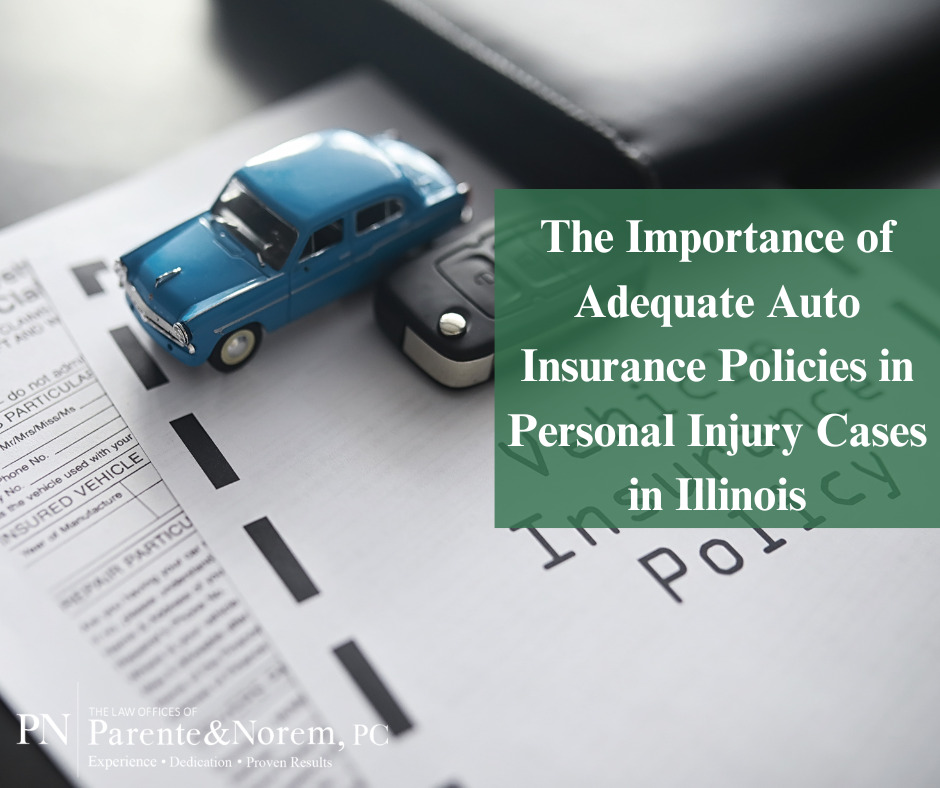
P&N BLOG | The Importance of Adequate Auto Insurance Policies in Personal Injury Cases in Illinois
Car accidents are unpredictable and can happen to anyone at any time. The consequences can range from minor inconveniences to severe, life-altering injuries that require ongoing medical care. In these situations, the auto insurance policies you carry play a crucial role in determining the compensation available for your injuries and damages. In Illinois, having sufficient auto insurance coverage is not just a legal requirement; it’s a necessity for financial protection.
Why Auto Insurance Policies Matter
Auto insurance serves as a financial safety net, covering damages and injuries sustained in accidents. It ensures that injured parties receive compensation for medical expenses, lost wages, pain and suffering, and other economic and non-economic losses. Without adequate coverage, accident victims may face significant financial burdens that could impact their lives for years to come.
Understanding Illinois Auto Insurance Laws
Illinois law mandates that all drivers carry basic auto insurance coverage, known as the 25/50/20 minimum liability limits. This means that if an insured driver causes an accident, their insurance provider will cover:
- Up to $25,000 for bodily injury per person
- Up to $50,000 for total bodily injury per accident
- Up to $20,000 for property damage
While these minimums are legally required, they may not be sufficient to cover all expenses resulting from a serious accident. Medical bills, vehicle repairs, and lost wages can quickly exceed these limits, leaving drivers financially vulnerable.
The Need for Adequate Auto Insurance Coverage
Personal injury claims in Illinois are typically filed against the at-fault driver’s insurance. If the at-fault driver’s coverage is insufficient, victims may struggle to recover the full extent of their damages. To avoid financial hardship, it is advisable to carry higher-limit insurance policies that provide broader protection.
Additionally, drivers should consider purchasing uninsured/underinsured motorist coverage. This type of coverage protects you if you are involved in an accident with a driver who either lacks insurance or does not have enough coverage to pay for your damages. Having this extra layer of protection can mean the difference between financial stability and significant out-of-pocket expenses following an accident.
Auto insurance is a critical tool for mitigating the financial risks associated with car accidents. In Illinois, personal injury claimants depend primarily on the at-fault driver’s insurance for compensation, making it essential to have adequate coverage. By opting for high-limit policies and supplemental protections such as uninsured/underinsured motorist coverage, drivers can safeguard themselves against unexpected financial burdens. Investing in comprehensive auto insurance provides not only legal compliance but also peace of mind, ensuring that you are fully protected whenever you’re on the road.
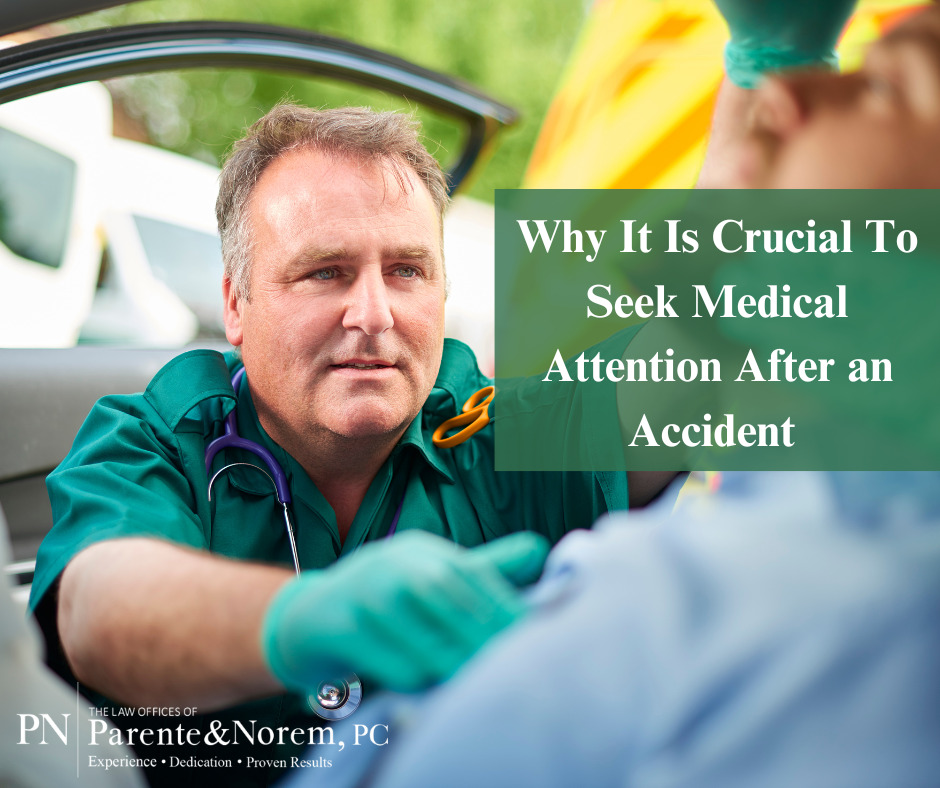
P&N BLOG | Why It Is Crucial To Seek Medical Attention After an Accident
Car accidents are often overwhelming experiences, leaving victims unsure of what steps to take next. After a collision, it might be tempting to brush off minor discomfort or assume you’re unharmed. However, seeking immediate medical attention is essential, even if you feel fine. This crucial step can protect both your health and your potential personal injury claim. Let’s explore the reasons why prompt medical care is necessary after a car accident in Illinois.
The Hidden Dangers of Delayed Symptoms
The body’s natural response to trauma includes a surge of adrenaline, which can temporarily mask pain and injuries. As a result, many car accident injuries do not present immediate symptoms. Headaches, dizziness, neck or back pain, and numbness in extremities are all signs that may appear hours, days, or even weeks later. Ignoring these symptoms can lead to serious complications and prolonged recovery times.
For example, dizziness following an accident may indicate a concussion or whiplash. Seeking medical evaluation right away ensures that any underlying injuries are diagnosed early, allowing for timely and effective treatment.
Protecting Your Right to Compensation
If you plan to file a personal injury claim, obtaining medical care as soon as possible is important. Illinois law imposes a statute of limitations on personal injury cases, meaning there is a limited time to file a claim. Delaying medical treatment can weaken your case by making it harder to connect your injuries directly to the accident.
Medical records serve as vital evidence in personal injury claims, demonstrating the extent of your injuries and the treatment received. Insurance companies often scrutinize gaps in medical treatment, using them to argue that injuries were unrelated to the accident or not severe enough to warrant compensation. Seeking medical care promptly helps counter these tactics and strengthens your claim.
Establishing Causation and Damages
Receiving immediate medical attention also helps create a clear timeline of events, making it easier to prove that your injuries were caused by the accident. A comprehensive medical evaluation can uncover less visible injuries, such as internal damage or soft tissue injuries, which may not be immediately apparent but can have serious long-term effects.
Having thorough medical documentation is key to pursuing compensation for medical expenses, lost wages, and pain and suffering. The sooner you seek treatment, the stronger your claim will be.
Preventing Long Term Health Consequences
Failing to address injuries right away can lead to chronic conditions, reduced mobility, and ongoing pain. For example, concussions and other head injuries might not show immediate symptoms but can cause significant cognitive and physical issues if left untreated.
Additionally, some injuries require early intervention for the best possible recovery. Seeking prompt medical care ensures that you receive the necessary treatment, helping to prevent further complications and long-term health challenges.
Meeting the Legal Duty to Mitigate Damages
Under Illinois law, personal injury victims have a “duty to mitigate” damages, meaning they must take reasonable steps to minimize the impact of their injuries. Seeking medical treatment promptly is a fundamental part of fulfilling this legal obligation.
Failure to seek timely medical attention can result in reduced compensation. Insurance companies and courts may argue that any worsening of your condition is due to your own negligence, limiting the damages you can recover. By prioritizing medical care, you protect your legal rights and improve your chances of receiving fair compensation.
Take Action to Protect Your Health and Legal Rights
Seeking immediate medical attention after a car accident is essential for both your health and any potential legal claims. It ensures that hidden injuries are diagnosed and treated early, prevents long-term complications, and strengthens your case for compensation.
Your wellbeing should always come first. If you or a loved one has been injured in an accident, don’t delay in seeking medical care. Additionally, consulting with a personal injury attorney can help you understand your rights and navigate the legal process effectively.
For a free case evaluation, contact The Law Offices of Parente & Norem, P.C. today at 312.641.5926 or fill out a contact form on our website. Our experienced attorneys are here to help you every step of the way.
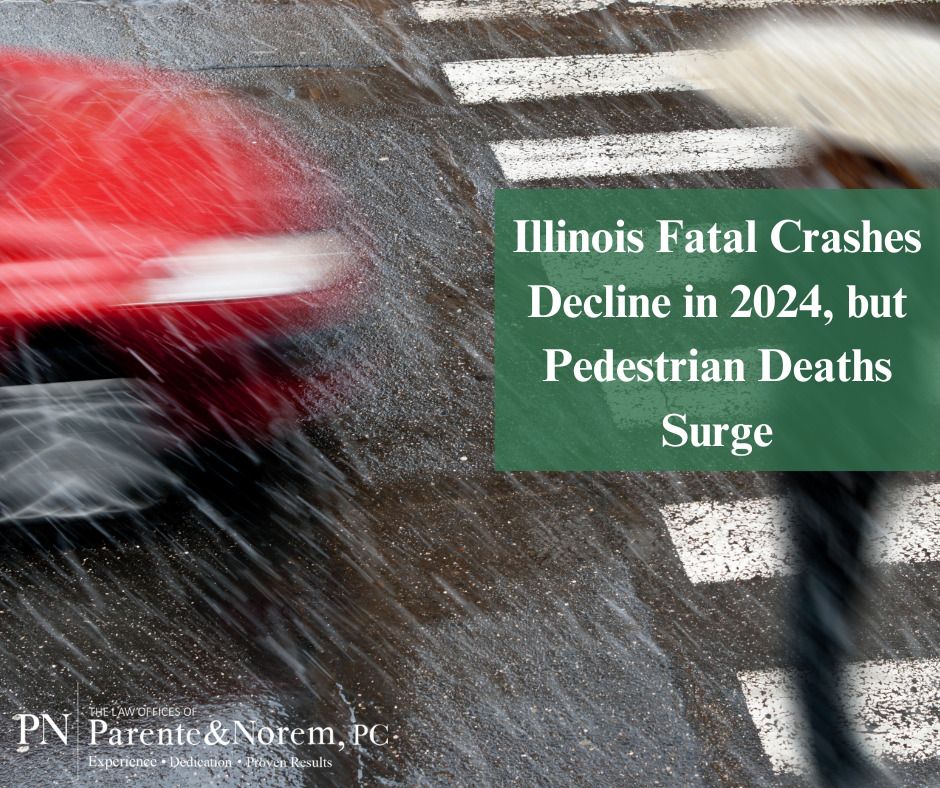
P&N BLOG | Illinois Fatal Crashes Decline in 2024, but Pedestrian Deaths Surge
New data from the Illinois Department of Transportation (IDOT) offers a mixed bag of news regarding traffic safety in Illinois. While fatal vehicle crashes in 2024 fell to their lowest levels since 2020, the number of pedestrian fatalities remains alarmingly high.
Encouraging Trends in Fatal Vehicle Crashes
In 2024, IDOT reported 1,103 fatal traffic crashes across Illinois, resulting in 1,196 deaths. These figures mark a 3.5% decline compared to 2023. Additionally, there were significant decreases in specific types of crashes:
- Cyclist fatalities: Dropped from 41 in 2023 to 35 in 2024, a 14.6% decrease, though still above the seven-year average of 30.
- Work zone fatalities: Plummeted from 24 in 2023 to just 13 in 2024.
- Motorcycle-related deaths: Fell by 9.3%, from 162 in 2023 to 147 last year.
These declines suggest progress in areas such as work zone safety and awareness campaigns targeting motorcyclists and cyclists.
The Persistent Problem of Pedestrian Deaths
While overall fatalities have decreased, pedestrian deaths have surged, highlighting a critical issue in Illinois traffic safety. In 2024, 219 pedestrians lost their lives in crashes, a 9.5% increase from the 200 fatalities recorded in 2023.
The six-county region of Cook, DuPage, Kane, Lake, McHenry, and Will counties saw 144 pedestrian fatalities in 2024, up 6.7% from 135 the previous year. This rise mirrors a national trend that has been ongoing for over a decade. “Since 2010, there has been nationally a huge increase in the number of people killed while walking,” said Victoria Barrett, Senior Transportation Planner at the Chicago Metropolitan Agency for Planning (CMAP).
Why Are Pedestrian Fatalities Increasing?
Several factors contribute to the rise in pedestrian deaths:
Vehicle Design: Research by the Insurance Institute for Highway Safety reveals that larger vehicles like SUVs, pickups, and vans with taller hood heights are significantly more likely to cause fatal injuries to pedestrians. Unlike sedans, which tend to strike a pedestrian’s legs, larger vehicles often hit the torso or head, where vital organs are located.
Distracted Driving and Speeding: Both Barrett and Alex Perez, Advocacy Manager at the Active Transportation Alliance, note that distracted driving and pandemic-era speeding habits remain major contributors to collisions. Reduced traffic enforcement has exacerbated these issues.
Street Design: Suburban roads like North Avenue, characterized by fast-moving traffic and multiple lanes, are especially hazardous for pedestrians and cyclists.
Long-Term Trends: Professor Ian Savage from Northwestern University points out that pedestrian and cyclist fatalities have made up an increasing proportion of total traffic deaths in Illinois since the pandemic, rising from 18.3% in 2019 to 21.2% in 2024.
Efforts to Improve Safety for Vulnerable Road Users
State and local authorities are taking action to address these alarming trends. Here are some of the ongoing initiatives:
- IDOT’s Vulnerable Road User Safety Assessment: This recently completed report identifies high-risk areas and crash trends to prioritize safety for pedestrians and cyclists.
- Safe Travel for All Program: CMAP is working with Cook and neighboring counties to develop strategies aimed at reducing traffic deaths and injuries. An open house for the program will be held on February 22 at the Centre of Elgin.
- Increased Focus on Pedestrian Safety: “One fatality is one too many,” said IDOT Communications Director Guy Tridgell. The department is investing more time and resources into identifying tools and policies that improve safety for vulnerable road users.
The Road Ahead
While progress has been made in reducing overall fatal crashes, the rise in pedestrian deaths underscores the urgent need for further action. Enhanced vehicle design standards, stricter traffic enforcement, and improved road infrastructure could all play a role in reversing this trend. For pedestrians and cyclists, safety on Illinois roads remains a pressing concern that requires attention from policymakers, drivers, and communities alike.
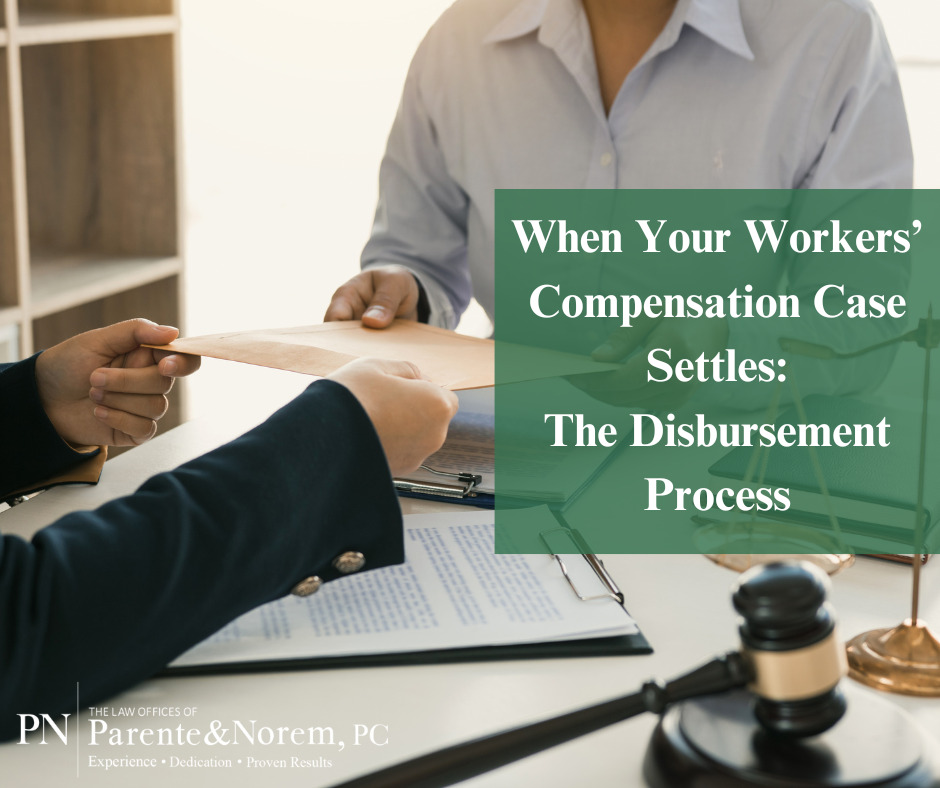
P&N BLOG | When Your Workers’ Compensation Case Settles – The Disbursement Process
After what can feel like a long process, the time has come for your workers’ compensation case to either win a verdict or reach a settlement. So now what? When dealing with a workers’ compensation case or any legal matter that involves a settlement, understanding the process can ease a lot of confusion.
At the Law Offices of Parente & Norem, P.C., we do everything we can to have your funds dispersed to you in a timely manner. The process is two-fold; there’s the final work your attorney needs to do to complete your file, as well as an operational component that ensures all guidelines have been followed in order to have your funds dispersed free and clear of any more ‘red tape.’ Here’s a detailed breakdown of what happens from the time of verdict/settlement to the final disbursement of funds.
The Attorney Process
Settlement Contracts
Once the settlement agreement is reached, the plaintiff’s attorney drafts a document called a settlement contract.
This document outlines the settlement terms, including the payment amount, any bills that will be paid from the settlement, and legal releases for the defendant from any further liability for the incident in question.By signing this document, the plaintiff agrees not to pursue any additional claims related to the same event.
Limited Power of Attorney
Once settlement documents are executed,the attorney provides a Limited Power of Attorney (LPOA) form to the client for their signature. This allows the attorney to deposit the settlement funds into the client’s trust account once received. It also permits the attorney to negotiate and resolve liens or outstanding medical bills related to the case, which helps maximize the client’s net recovery.
Settlement Fund Timeline
After all paperwork is signed and submitted, it typically takes 60-90 days for the settlement funds to be processed and sent to the plaintiff’s attorney.
The Operational Process
After the funds are deposited into the client trust account and all bills and liens are resolved, the attorney prepares a settlement disbursement packet, which includes a breakdown of the settlement amounts. This packet is passed to the operations or accounting team for processing.
Disbursement of Funds
Once all numbers align with the total settlement amount, checks are issued in the names of the client and any medical providers.
The client is invited to the attorney’s office for a final disbursement meeting, where they review the settlement breakdown, ask any questions, and sign the closing statement.
Final Steps
After signing the closing statement, the client authorizes the attorney to send checks to medical providers for their portion of the settlement. The client receives their net settlement check, which reflects the amount left after deductions for liens, legal fees, and other case-related expenses.
Once all payments are made, the case file is officially closed.
The settlement process can seem complex when your personal injury case is resolved, but with a knowledgeable attorney here at The Law Offices of Parente & Norem guiding you, it’s designed to protect your rights and maximize your recovery. From negotiating the terms of the release to ensuring every dollar is accounted for, this process ensures that you receive what you deserve while addressing any financial obligations tied to your case.
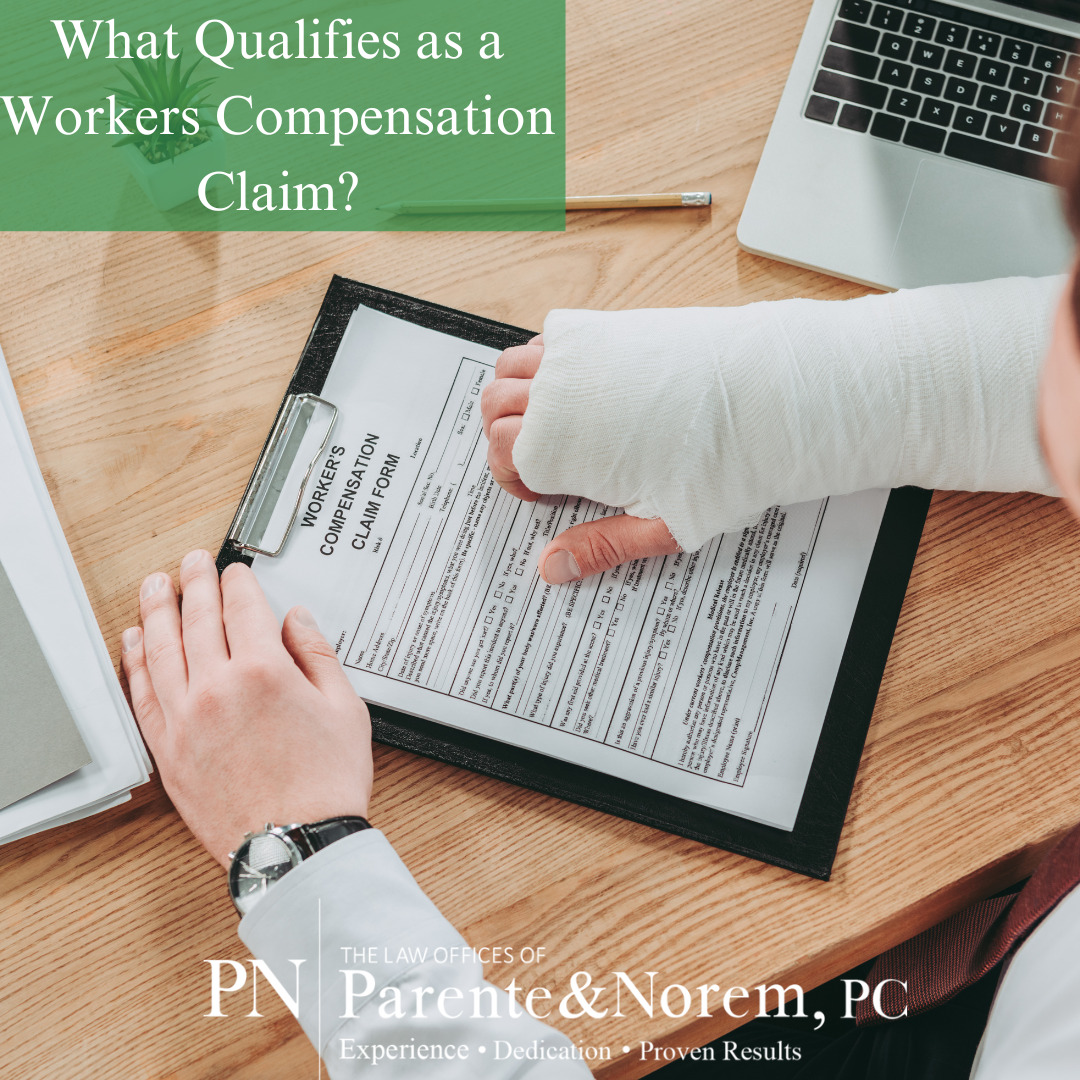
P&N BLOG | What Qualifies as a Workers Compensation Claim?
Workplace injuries can be physically, emotionally, and financially devastating. Fortunately, the Illinois Workers’ Compensation Act is designed to protect injured employees by requiring employers to cover medical treatment, lost wages, retraining if you can no longer perform your previous job, and compensation for any permanent disabilities. However, the process is not always straightforward, and securing your benefits may require navigating a complex system.
At The Law Offices of Parente & Norem, P.C., we are here to help you every step of the way. Our experienced attorneys understand the intricacies of the Illinois Workers’ Compensation system and are dedicated to ensuring you receive the benefits you are entitled to while alleviating much of the burden from your shoulders.
Common Challenges in Workers’ Compensation Claims
Workers’ compensation claims can be costly for employers, which may lead to disputes over your eligibility for certain benefits. Additionally, the process involves legal and bureaucratic complexities that can be overwhelming, especially while you are recovering from an injury. This is where the guidance of an attorney becomes invaluable.
Our skilled team will file your initial claim, manage the necessary documentation, represent you in hearings, ensure you get proper medical treatment, and handle settlement negotiations to secure the maximum compensation you deserve. If your claim is unjustly denied, we are prepared to take your case to court to fight for your rights.
The Illinois Workers’ Compensation Process
To help you understand what to expect, here is an overview of the Illinois Workers’ Compensation process:
Notice of Injury
Notify your employer of the injury as soon as possible, but no later than 45 days after the incident. Prompt notification makes it harder for your employer to dispute that the injury occurred at work.
Initial Treatment
After a workplace injury, seek medical attention immediately. If possible, go straight from the accident site to a hospital or clinic for diagnosis and treatment. You have the right to choose your healthcare provider, and all medical expenses should be covered by your employer without any out-of-pocket costs to you. If symptoms emerge later, seek medical attention as soon as possible.
Notice of Work Restrictions
Obtain documentation from your healthcare provider regarding any work restrictions and inform your employer. This ensures that you comply with medical advice and establishes a record of your limitations.
Filing a Claim
We will file an Application for Adjustment of Claim with the Illinois Workers’ Compensation Commission, accompanied by an Attorney Representation Agreement naming our firm as your legal advocate. Our team will closely monitor your case and address any issues that arise, including appearing before the Commission to protect your rights.
Ongoing Medical Treatment
Your employer is responsible for covering all reasonable and necessary medical treatment related to your work injury until you reach Maximum Medical Improvement (MMI). MMI signifies the point at which further treatment will no longer improve your condition.
Independent Medical Examination (IME)
Your employer may request that you undergo an IME conducted by a non-treating physician to assess your condition, treatment needs, and work restrictions. Consult with your attorney before attending an IME to ensure your rights are protected.
Resolving Treatment Disputes
If there is a disagreement between your treating doctor and the IME physician, your attorney can request a hearing to resolve the dispute and advocate for your best interests.
Negotiating Additional Benefits
In cases where your injury prevents you from returning to your previous occupation, your employer may be required to cover retraining costs or provide a lump-sum settlement. We will negotiate on your behalf to ensure you receive fair compensation.
Why Choose Parente & Norem?
When you are dealing with a severe workplace injury, focusing on your recovery should be your top priority. Let us handle the complexities of the Workers’ Compensation process. Our attorneys have years of experience representing clients before the Illinois Workers’ Compensation Commission and in court. From filing claims to negotiating settlements, we are committed to achieving the best possible outcome for you.
Contact Us for a Free Consultation
If you or a loved one has suffered a work injury, don’t navigate the Workers’ Compensation system alone. Contact The Law Offices of Parente & Norem, P.C., at 312.641.5926 for a free consultation. Let us provide the support and legal expertise you need to secure your benefits and focus on healing.
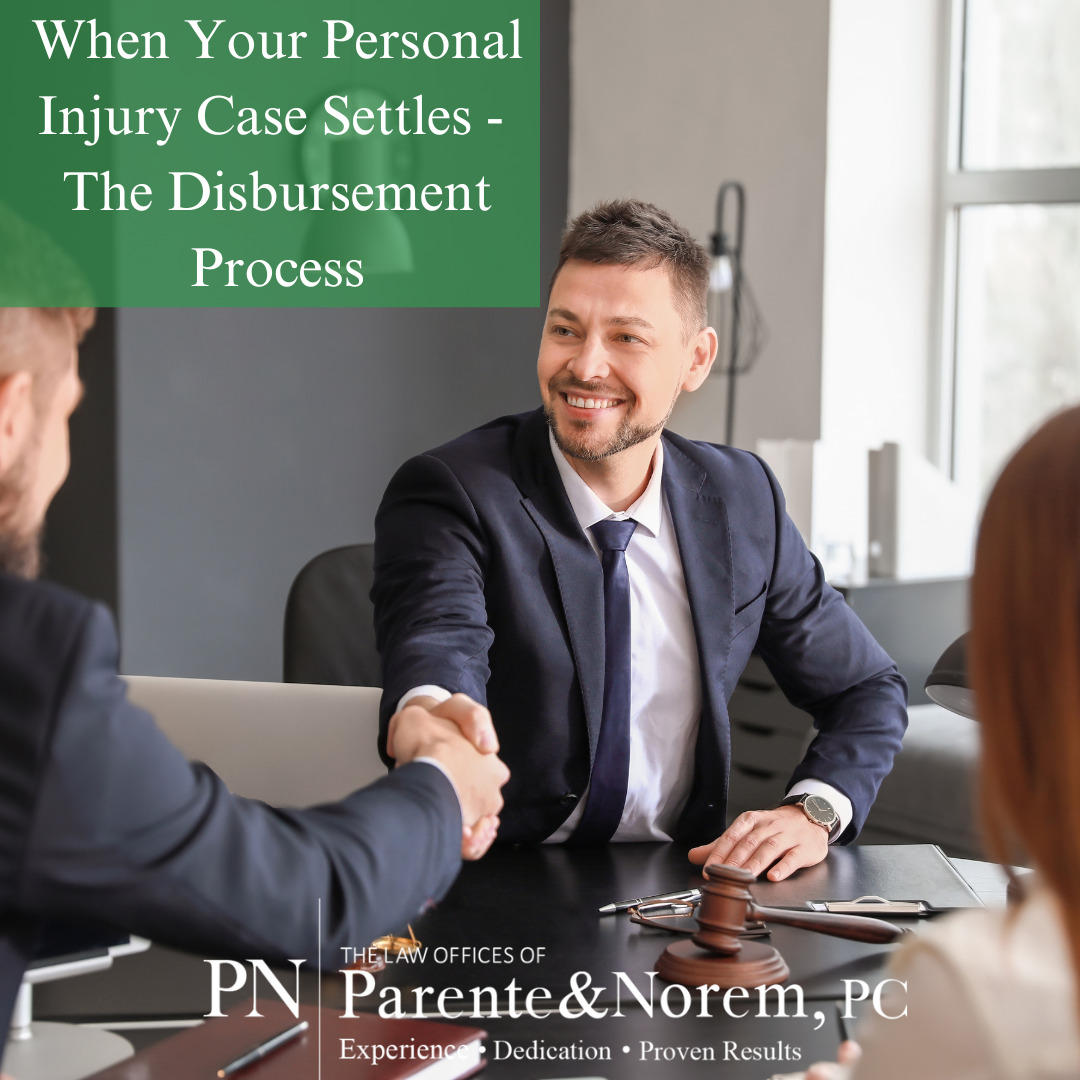
P&N Blog | When Your Personal Injury Case Settles – The Disbursement Process
When Your Personal Injury Case Settles – The Disbursement Process
After what can feel like a long process, the time has come for your personal injury case to either win a verdict or reach a settlement. So now what? When dealing with a personal injury case or any legal matter that involves a settlement, understanding the process can ease a lot of confusion.
At the Law Offices of Parente & Norem, P.C., we do everything we can to have your funds dispersed to you in a timely manner. The process is two-fold; there’s the final work your attorney needs to do to complete your file, as well as an operational component that ensures all guidelines have been followed in order to have your funds dispersed free and clear of any more ‘red tape.’ Here’s a detailed breakdown of what happens from the time of verdict/settlement to the final disbursement of funds.
The Attorney Process
Release of Claims
Once the settlement agreement is reached, the insurance company or defense counsel sends the plaintiff’s attorney a document called a release of claims.
- This document outlines the settlement terms, including the payment amount, and legally releases the defendant from any further liability for the incident in question.
- By signing this document, the plaintiff agrees not to pursue any additional claims related to the same event.
Attorney Review
The plaintiff’s attorney thoroughly reviews the release to ensure:
- The terms match what was negotiated.
- The agreement serves the client’s best interests.
Once satisfied, the attorney sends the release to the client for their signature.
Limited Power of Attorney (LPOA)
Along with the release, the attorney provides a Limited Power of Attorney (LPOA) form.
- This allows the attorney to deposit the settlement funds into the client’s trust account once received.
- It also permits the attorney to negotiate and resolve liens or outstanding medical bills related to the case, which helps maximize the client’s net recovery.
Settlement Fund Timeline
After all paperwork is signed and submitted, it typically takes 30 to 60 days for the settlement funds to be processed and sent to the plaintiff’s attorney.
The Operational Process
Negotiating and Resolving Liens
Once the attorney receives the settlement funds, they negotiate lien payoff amounts and finalize payments for any outstanding medical bills.
- This ensures the client receives the maximum possible net settlement.
Settlement Disbursement Packet
After resolving all liens, the attorney prepares a settlement disbursement packet, which includes a breakdown of the settlement amounts. This packet is passed to the operations or accounting team for processing.
Disbursement of Funds
- Once all numbers align with the total settlement amount, checks are issued in the names of the client and any medical providers.
- The client is invited to the attorney’s office for a final disbursement meeting, where they review the settlement breakdown, ask any questions, and sign the closing statement.
Final Steps
- After signing the closing statement, the client authorizes the attorney to send checks to medical providers for their portion of the settlement.
- The client receives their net settlement check, which reflects the amount left after deductions for liens, legal fees, and other case-related expenses.
- Once all payments are made, the case file is officially closed.
The settlement process can seem complex when your personal injury case is resolved, but with a knowledgeable attorney here at The Law Offices of Parente & Norem guiding you, it’s designed to protect your rights and maximize your recovery. From negotiating the terms of the release to ensuring every dollar is accounted for, this process ensures that you receive what you deserve while addressing any financial obligations tied to your case.
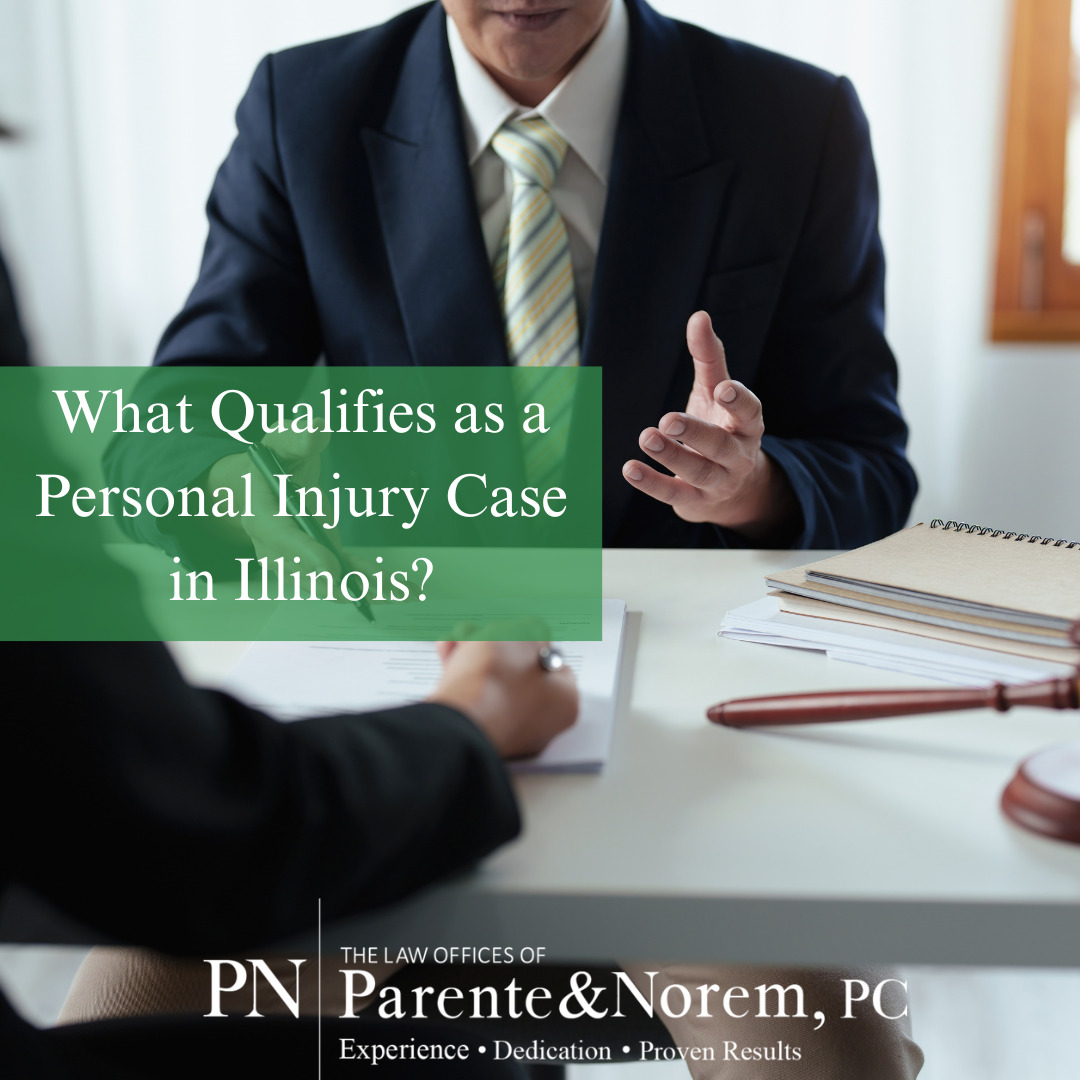
P&N BLOG | What Qualifies as a Personal Injury Case in Illinois?
A personal injury case arises when someone suffers harm due to the negligence or intentional actions of another party. In Illinois, the legal framework allows plaintiffs to seek compensation for injuries caused by incidents such as car/transportation accidents, medical malpractice, wrongful death, and more. These cases aim to provide financial recovery for medical expenses, lost wages, pain and suffering, and other damages. On today’s blog, we’ll break down the essentials of personal injury cases in Illinois to help you understand your rights and options.
Types of Personal Injury Cases in Illinois
Car Accidents Car accidents are among the most common personal injury cases in Illinois. Often caused by negligent actions like distracted driving, speeding, or drunk driving, these incidents can result in severe injuries. Illinois is a fault-based state, meaning the responsible party’s insurance covers damages.
Example: A driver runs a red light and collides with another vehicle, injuring the other driver. The injured driver can file a claim for medical expenses and lost wages.
Truck Accidents Due to the size and weight of commercial vehicles, truck accidents often result in catastrophic injuries. These cases may involve multiple parties, including the truck driver, trucking company, and even manufacturers of defective truck parts. Federal regulations, such as those from the Federal Motor Carrier Safety Administration (FMCSA), also come into play.
Example: A truck driver falls asleep at the wheel, causing a multi-vehicle collision on I-294. Victims can pursue claims against the driver and trucking company for negligence.
Slip and Fall Accidents Slip and fall cases, or premises liability claims, occur when someone is injured due to hazardous conditions on another’s property. Illinois law requires property owners to keep their premises reasonably safe. Plaintiffs must prove that the owner knew or should have known about the danger but failed to address it.
Example: A grocery store customer slips on a wet floor without warning signs and breaks their arm. The injured party can sue the store for negligence.
Dog Bites Illinois has a strict liability law for dog bites. Dog owners are automatically liable for injuries caused by their pets, provided the victim was lawfully on the property and did not provoke the animal.
Example: A child playing in a neighbor’s yard is bitten by their dog. The parents can file a claim for medical costs and emotional distress.
Wrongful Death When a person dies due to someone else’s negligence or intentional conduct, their family can file a wrongful death claim. Eligible family members, such as a spouse or children, may seek compensation for funeral expenses, loss of financial support, and emotional suffering.
Example: A pedestrian is struck and killed by a drunk driver. The family files a wrongful death lawsuit against the driver for their losses.
Product Liability These cases arise when defective or dangerous products cause injury. Illinois follows strict liability, meaning plaintiffs need only prove the product was defective and caused harm—not that the manufacturer was negligent.
Example: A defective airbag deploys improperly, causing injuries. The injured party can sue the manufacturer for producing a faulty product.
Key Legal Principles in Illinois Personal Injury Cases
Negligence Proving negligence involves demonstrating that:
- The defendant owed a duty of care.
- The defendant breached that duty.
- The breach caused the plaintiff’s injury (causation).
- The plaintiff suffered damages.
Comparative Negligence Illinois follows a modified comparative negligence rule. If you’re partially at fault for your injury, your compensation is reduced by your percentage of fault. However, if you’re more than 50% responsible, you cannot recover damages.
Statute of Limitations In Illinois, the statute of limitations for personal injury cases is generally two years from the date of injury. Missing this deadline likely forfeits your right to compensation.
Damages in Illinois Personal Injury Cases
Economic Damages These include measurable financial losses such as medical bills, lost wages, and property damage.
Non-Economic Damages Compensation for intangible losses, including pain and suffering, emotional distress, and loss of companionship.
Punitive Damages In rare cases, punitive damages may be awarded to punish particularly reckless or malicious behavior.
Navigating Illinois Personal Injury Cases
Burden of Proof The plaintiff must prove their case by a preponderance of the evidence—meaning it is more likely than not that the defendant’s actions caused the injury.
Insurance Involvement Insurance companies often defend claims and negotiate settlements. An experienced attorney can help ensure you receive a fair settlement.
Settlement vs. Trial Most cases settle out of court. However, if a fair resolution isn’t possible, your case may proceed to trial, where a judge or jury will determine the outcome.
How We Can Help
At The Law Offices of Parente & Norem, P.C., we understand how overwhelming a personal injury can be. Our experienced attorneys are committed to helping you navigate the legal system and secure the compensation you deserve. From car accidents to wrongful death claims, we’re here to fight for justice on your behalf.
Contact us today at 312.641.5926 to schedule a free consultation. Your path to justice begins with us.
